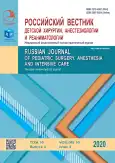Энтеральная нервная система толстой кишки в условиях ишемии: экспериментальное исследование
- Авторы: Пименова Е.С.1, Корчагина Н.С.2, Королев Г.А.1, Зюзько Д.Д.1, Саакян М.С.3, Морозов Д.А.1
-
Учреждения:
- Федеральное государственное автономное образовательное учреждение высшего образования Первый Московский государственный медицинский университет имени И.М. Сеченова Министерства здравоохранения Российской Федерации (Сеченовский Университет)
- Государственное бюджетное учреждение здравоохранения города Москвы «Детская городская клиническая больница № 13 имени Н.Ф. Филатова Департамента здравоохранения города Москвы»
- Федеральное государственное бюджетное учреждение дополнительного профессионального образования «Центральная государственная медицинская академия» Управления делами Президента Российской Федерации
- Выпуск: Том 10, № 4 (2020)
- Страницы: 401-410
- Раздел: Оригинальные исследования
- URL: https://journals.rcsi.science/2219-4061/article/view/122937
- DOI: https://doi.org/10.17816/psaic703
- ID: 122937
Цитировать
Полный текст
Аннотация
Введение. Патология энтеральных нервных ганглиев может быть причиной различных заболеваний (болезни Гиршпрунга, нейрональной интестинальной дисплазии, ганглионейроматоза, болезни Шагаса). Причины приобретенного поражения кишечных ганглиев до конца не изучены. Высказывается предположение, что одной из причин ганглиопатии может быть нарушение кровоснабжения кишечника.
Цель. Оценка функции макро- и микроскопических изменений толстой кишки у крыс на фоне хронической мезентериальной ишемии.
Материалы и методы. Эксперимент проведен на 20 крысах Sprague Dawley. Хроническую мезентериальную ишемию воспроизводили путем лигирования концевых брыжеечных сосудов рядом с нисходящей ободочной кишкой. После операции оценивали аппетит животных, характер стула. Повторную операцию выполняли через 7 (n = 1), 9 (n = 2), 12 (n = 2), 14 (n = 1), 21 (n = 1), 42 (n = 1), 53 (n = 1), 62 (n = 1) суток. Оценивали внешний вид кишечника, содержимое толстой кишки. В экспериментальной группе выполняли биопсию толстой кишки в зоне ишемии и в вышележащих отделах с нормальным кровотоком.
Результаты. У 90 % крыс после лигирования мезентериальных сосудов отметили изменение стула (урежение/отсутствие, размягчение, явления гемоколита). При повторной операции у 30 % отметили стеноз ишемизированного участка кишки, у 70 % — расширение кишечника выше зоны лигирования (явления частичной непроходимости кишечника). Некроз в зоне ишемии отмечен у 20 % крыс. У 40 % отмечено спонтанное подпаивание сальника к ранее скелетированному сегменту. При микроскопии выявили воспалительную инфильтрацию слизистой оболочки толстой кишки у 70 % в зоне ишемии, у 50 % — в здоровых участках. При подсчете энтеральных ганглиев установили статистически значимое снижение последних в зоне ишемии в сравнении с интактной кишкой (тест Вилкоксона, р = 0,005).
Заключение. На фоне хронической мезентериальной ишемии отмечается нарушение функции толстой кишки, снижение количества интрамуральных нервных ганглиев.
Ключевые слова
Полный текст
Открыть статью на сайте журналаОб авторах
Евгения Сергеевна Пименова
Федеральное государственное автономное образовательное учреждение высшего образования Первый Московский государственный медицинский университет имени И.М. Сеченова Министерства здравоохранения Российской Федерации (Сеченовский Университет)
Автор, ответственный за переписку.
Email: evgeniyapimenova@list.ru
ORCID iD: 0000-0001-5730-3684
канд. мед. наук, доцент кафедры детской хирургии и урологии-андрологии им. Л.П. Александрова
Россия, МоскваНаталья Сергеевна Корчагина
Государственное бюджетное учреждение здравоохранения города Москвы «Детская городская клиническая больница № 13 имени Н.Ф. Филатова Департамента здравоохранения города Москвы»
Email: nskorchagina@gmail.com
врач-патологоанатом
Россия, МоскваГригорий Алексеевич Королев
Федеральное государственное автономное образовательное учреждение высшего образования Первый Московский государственный медицинский университет имени И.М. Сеченова Министерства здравоохранения Российской Федерации (Сеченовский Университет)
Email: KorolevG.A@yandex.ru
клинический ординатор кафедры детской хирургии и урологии-андрологии им. Л.П. Александрова
Россия, МоскваДарья Дмитриевна Зюзько
Федеральное государственное автономное образовательное учреждение высшего образования Первый Московский государственный медицинский университет имени И.М. Сеченова Министерства здравоохранения Российской Федерации (Сеченовский Университет)
Email: yakoven@yandex.ru
клинический ординатор кафедры детской хирургии и урологии-андрологии им. Л.П. Александрова
Россия, МоскваМаргарита Степановна Саакян
Федеральное государственное бюджетное учреждение дополнительного профессионального образования «Центральная государственная медицинская академия» Управления делами Президента Российской Федерации
Email: margaritasaakyan@yandex.ru
клинический ординатор кафедры хирургии с курсом эндоскопии
Россия, МоскваДмитрий Анатольевич Морозов
Федеральное государственное автономное образовательное учреждение высшего образования Первый Московский государственный медицинский университет имени И.М. Сеченова Министерства здравоохранения Российской Федерации (Сеченовский Университет)
Email: damorozov@list.ru
д-р мед. наук, профессор, заведующий кафедрой детской хирургии и урологии-андрологии им. Л.П. Александрова
Россия, МоскваДополнительные файлы








